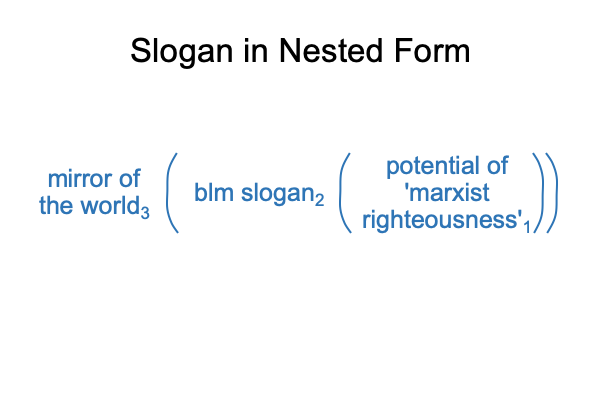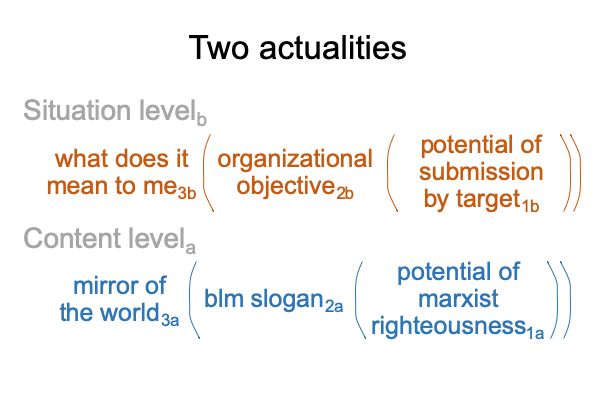0001 Sociology is often a curious field of inquiry. In the mirror of the world3, there is only one Be Little Men movement (blm). Blm is a slogan2. No substitutions to these words are allowed. The potential1 underlying the slogan2 is fixed on the only possibility among a sea of possible meanings, presences and messages. That potential is the possibility of marxist righteousness1.
Here is a picture of a triadic relation, as introduced in A Primer on the Category-Based Nested Form.

0002 What is marxist righteousness1?
Marx is a “communist” who names his enemy, the “capitalist”.
The specter of “capitalism”?
Das Kapital?
The root word for “capital” is “head”.
Wrap your cap around that.
0003 Marxist righteousness1 relies on the emptiness of spoken words. A speech-alone word is merely a placeholder in a system of differences. Meaning, presence and message must be projected into each spoken word. The marxist reserves the right to project that meaning, presence and message.
Allow no substitutes.
Substitutions squander the purity of the projection.
0004 What does this mean to me3?
This is what the target of a marxist slogan never asks.
The slogan isolates the guilty.
Originally, the capitalist is the one upon which marxist righteousness descends. The target is guilty, with no option of managing the label, except through submission1. Indeed, the organizational objective2 is to manifest submission1.
Now, other labels serve as slogans2a.
This second nested form situates the first nested form, as described in A Primer on Sensible and Social Construction.

0005 There are two blms. On the content level, blm is a slogan2a emerging from (and situating) righteousness1a. On the situation level, blm manifests organizational objectives2b that actualize the potential of submission1b, thus increasing the wealth, power and overall prowess3b of those reflecting the mirror of the world3a.
According to rumors, advertisers in saavy suites say that executive suits of major corporations donate large sums1b to an organization2b whose namesake is the slogan2a. Other, less well-endowed targets are suited up as scapegoats, following the historic and literary patterns noted by Rene Girard. Marxist righteousness projects a lack, held within the accuser, upon a scapegoat, the target.
0006 Yes, by definition1a, certain types can never submit1b. These characters are magically gifted with the power to create the lack that they are accused of1a as well as the standing to fill that lack with their own… shall I say?.. capitals1b.
0007 Is marxism a modern version of an ancient religion?
Surely, early civilizations sacrifice humans to their gods.
Remember the old adage?
A capitalist will sell the communist the rope to hang himself.
The joke works as long as the target does not comprehend the intent of the customer.
Why would anyone hang the fellow who sold “him” some rope?
Marxist righteousness calls the fellow, a “capitalist”.
The seller’s hanging manifests the realness of the marxist’s organizational objectives1b.
In the same way, ritual sacrifice validates the realness of ancient deities.
0008 What else does this imply?
The target is not privy to what does this mean to me3b. The deadly earnestness of marxist submission1b cannot be appreciated from the outside. The above two-level interscope is sensible only from the inside. The insider holds the secret knowledge3a that secures the slogan’s single possible meaning, presence and message1a.
If a gnostic path blossoms into a social movement, such as the be little men movement, then today’s secular academic sociologists include the topic in their regional and global meetings, showcasing how they are in tune with the emerging secret knowledge. They can explain it. They can write books about it. They can explore its righteousness1a, explicate its slogans2a, develop pathways for submission1b and extol its authority2b. They can conduct surveys in order to show how a slogan has struck a cord in social consciousness3a. They can tell all how the insider feels3b.
0009 Modern sociology is such a curious field of inquiry. It poses as a mirror3a of the worldc. As such, it constructs its own sensible approach, in the same fashion as marxist religions.
0010 Five related works are available at www.smashwords.com.
A Primer on the Category Based Nested Form
A Primer on Sensible and Social Construction
How To Define the Word “Religion”
Comments on Eric Santner’s Book (2016) “The Weight of All Flesh”
Comments on Peter Burfeind’s Book (2014) Gnostic America
